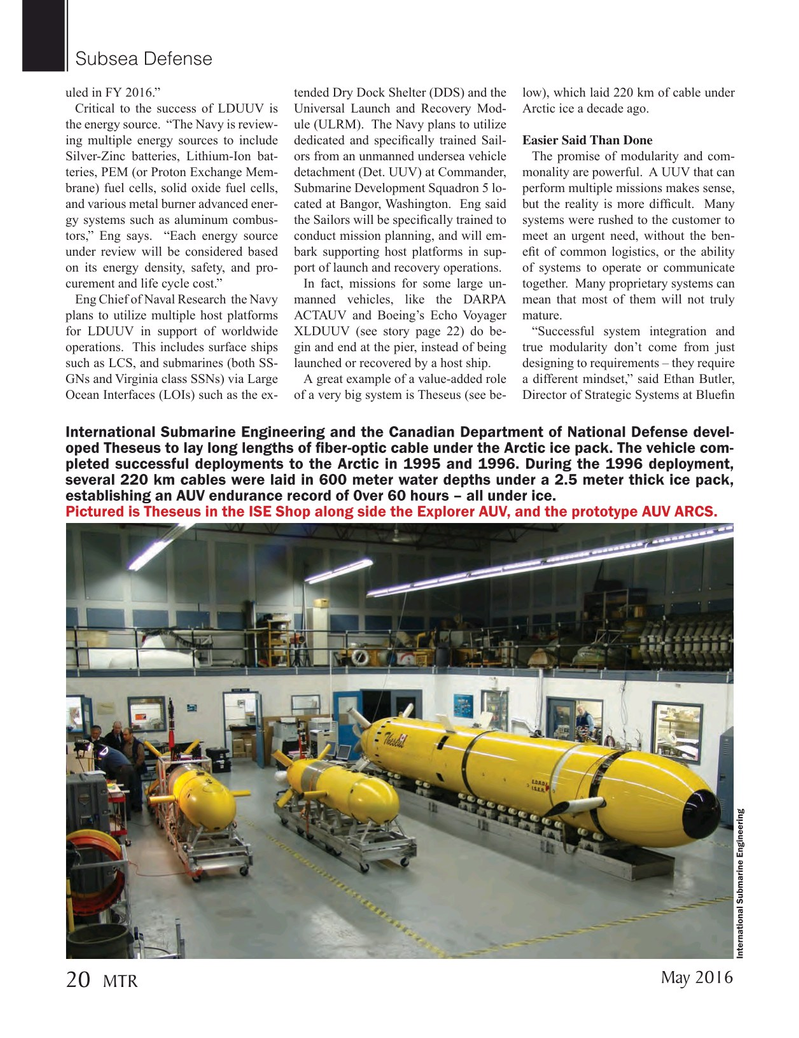
Page 20: of Marine Technology Magazine (May 2016)
Underwater Defense
Read this page in Pdf, Flash or Html5 edition of May 2016 Marine Technology Magazine
Subsea Defense uled in FY 2016.” tended Dry Dock Shelter (DDS) and the low), which laid 220 km of cable under
Critical to the success of LDUUV is Universal Launch and Recovery Mod- Arctic ice a decade ago. the energy source. “The Navy is review- ule (ULRM). The Navy plans to utilize ing multiple energy sources to include dedicated and speci? cally trained Sail- Easier Said Than Done
Silver-Zinc batteries, Lithium-Ion bat- ors from an unmanned undersea vehicle The promise of modularity and com- teries, PEM (or Proton Exchange Mem- detachment (Det. UUV) at Commander, monality are powerful. A UUV that can brane) fuel cells, solid oxide fuel cells, Submarine Development Squadron 5 lo- perform multiple missions makes sense, and various metal burner advanced ener- cated at Bangor, Washington. Eng said but the reality is more dif? cult. Many gy systems such as aluminum combus- the Sailors will be speci? cally trained to systems were rushed to the customer to tors,” Eng says. “Each energy source conduct mission planning, and will em- meet an urgent need, without the ben- under review will be considered based bark supporting host platforms in sup- e? t of common logistics, or the ability on its energy density, safety, and pro- port of launch and recovery operations. of systems to operate or communicate curement and life cycle cost.” In fact, missions for some large un- together. Many proprietary systems can
Eng Chief of Naval Research the Navy manned vehicles, like the DARPA mean that most of them will not truly plans to utilize multiple host platforms ACTAUV and Boeing’s Echo Voyager mature. for LDUUV in support of worldwide XLDUUV (see story page 22) do be- “Successful system integration and operations. This includes surface ships gin and end at the pier, instead of being true modularity don’t come from just such as LCS, and submarines (both SS- launched or recovered by a host ship. designing to requirements – they require
GNs and Virginia class SSNs) via Large A great example of a value-added role a different mindset,” said Ethan Butler,
Ocean Interfaces (LOIs) such as the ex- of a very big system is Theseus (see be- Director of Strategic Systems at Blue? n
International Submarine Engineering and the Canadian Department of National Defense devel- oped Theseus to lay long lengths of ? ber-optic cable under the Arctic ice pack. The vehicle com- pleted successful deployments to the Arctic in 1995 and 1996. During the 1996 deployment, several 220 km cables were laid in 600 meter water depths under a 2.5 meter thick ice pack, establishing an AUV endurance record of 0ver 60 hours – all under ice.
Pictured is Theseus in the ISE Shop along side the Explorer AUV, and the prototype AUV ARCS.
International Submarine Engineering
May 2016 20
MTR
MTR #4 (18-33).indd 20 4/28/2016 10:57:18 AM

 19
19

 21
21
